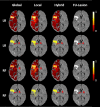Localized prediction of tissue outcome in acute ischemic stroke patients using diffusion- and perfusion-weighted MRI datasets
- PMID: 33152045
- PMCID: PMC7643995
- DOI: 10.1371/journal.pone.0241917
Localized prediction of tissue outcome in acute ischemic stroke patients using diffusion- and perfusion-weighted MRI datasets
Abstract
Background: An accurate prediction of tissue outcome in acute ischemic stroke patients is of high interest for treatment decision making. To date, various machine learning models have been proposed that combine multi-parametric imaging data for this purpose. However, most of these machine learning models were trained using voxel information extracted from the whole brain, without taking differences in susceptibility to ischemia into account that exist between brain regions. The aim of this study was to develop and evaluate a local tissue outcome prediction approach, which makes predictions using locally trained machine learning models and thus accounts for regional differences.
Material and methods: Multi-parametric MRI data from 99 acute ischemic stroke patients were used for the development and evaluation of the local tissue outcome prediction approach. Diffusion (ADC) and perfusion parameter maps (CBF, CBV, MTT, Tmax) and corresponding follow-up lesion masks for each patient were registered to the MNI brain atlas. Logistic regression (LR) and random forest (RF) models were trained employing a local approach, which makes predictions using models individually trained for each specific voxel position using the corresponding local data. A global approach, which uses a single model trained using all voxels of the brain, was used for comparison. Tissue outcome predictions resulting from the global and local RF and LR models, as well as a combined (hybrid) approach were quantitatively evaluated and compared using the area under the receiver operating characteristic curve (ROC AUC), the Dice coefficient, and the sensitivity and specificity metrics.
Results: Statistical analysis revealed the highest ROC AUC and Dice values for the hybrid approach. With 0.872 (ROC AUC; LR) and 0.353 (Dice; RF), these values were significantly higher (p < 0.01) than the values of the two other approaches. In addition, the local approach achieved the highest sensitivity of 0.448 (LR). Overall, the hybrid approach was only outperformed in sensitivity (LR) by the local approach and in specificity by both other approaches. However, in these cases the effect sizes were comparatively small.
Conclusion: The results of this study suggest that using locally trained machine learning models can lead to better lesion outcome prediction results compared to a single global machine learning model trained using all voxel information independent of the location in the brain.
Conflict of interest statement
I have read the journal's policy and the authors of this manuscript have the following competing interests: JF: Consultant for: Acandis, Boehringer Ingelheim, Cerenovus, Covidien, Evasc Neurovascular, MD Clinicals, Medtronic, Medina, Microvention, Penumbra, Route92, Stryker, Transverse Medical. By appointment of university hospital: CEO of Eppdata GmbH NDF: owns equity in Eppdata GmbH. This does not alter our adherence to PLOS ONE policies on sharing data and materials.
Figures

Similar articles
-
Comparison of MRI IVIM and MR perfusion imaging in acute ischemic stroke due to large vessel occlusion.Int J Stroke. 2020 Apr;15(3):332-342. doi: 10.1177/1747493019873515. Epub 2019 Sep 3. Int J Stroke. 2020. PMID: 31480940
-
Improved multi-parametric prediction of tissue outcome in acute ischemic stroke patients using spatial features.PLoS One. 2020 Jan 24;15(1):e0228113. doi: 10.1371/journal.pone.0228113. eCollection 2020. PLoS One. 2020. PMID: 31978179 Free PMC article.
-
Tissue outcome prediction in hyperacute ischemic stroke: Comparison of machine learning models.J Cereb Blood Flow Metab. 2021 Nov;41(11):3085-3096. doi: 10.1177/0271678X211024371. Epub 2021 Jun 23. J Cereb Blood Flow Metab. 2021. PMID: 34159824 Free PMC article.
-
Machine Learning Approaches to Identify Affected Brain Regions in Movement Disorders Using MRI Data: A Systematic Review and Diagnostic Meta-analysis.J Magn Reson Imaging. 2024 Dec;60(6):2518-2546. doi: 10.1002/jmri.29364. Epub 2024 Mar 27. J Magn Reson Imaging. 2024. PMID: 38538062
-
Applications of diffusion/perfusion magnetic resonance imaging in experimental and clinical aspects of stroke.Curr Atheroscler Rep. 2004 Jul;6(4):267-73. doi: 10.1007/s11883-004-0057-y. Curr Atheroscler Rep. 2004. PMID: 15191700 Free PMC article. Review.
Cited by
-
Artificial Intelligence as A Complementary Tool for Clincal Decision-Making in Stroke and Epilepsy.Brain Sci. 2024 Feb 28;14(3):228. doi: 10.3390/brainsci14030228. Brain Sci. 2024. PMID: 38539617 Free PMC article. Review.
-
Performance of Machine Learning for Tissue Outcome Prediction in Acute Ischemic Stroke: A Systematic Review and Meta-Analysis.Front Neurol. 2022 Jul 8;13:910259. doi: 10.3389/fneur.2022.910259. eCollection 2022. Front Neurol. 2022. PMID: 35873778 Free PMC article.
-
A comprehensive review for artificial intelligence on neuroimaging in rehabilitation of ischemic stroke.Front Neurol. 2024 Mar 28;15:1367854. doi: 10.3389/fneur.2024.1367854. eCollection 2024. Front Neurol. 2024. PMID: 38606275 Free PMC article. Review.
-
Intelligent Algorithm-Based MRI Image Features for Evaluating the Effect of Nursing on Recovery of the Neurological Function of Patients with Acute Stroke.Contrast Media Mol Imaging. 2022 May 31;2022:3936655. doi: 10.1155/2022/3936655. eCollection 2022. Contrast Media Mol Imaging. 2022. PMID: 35694710 Free PMC article.
References
Publication types
MeSH terms
LinkOut - more resources
Full Text Sources
Other Literature Sources
Medical

